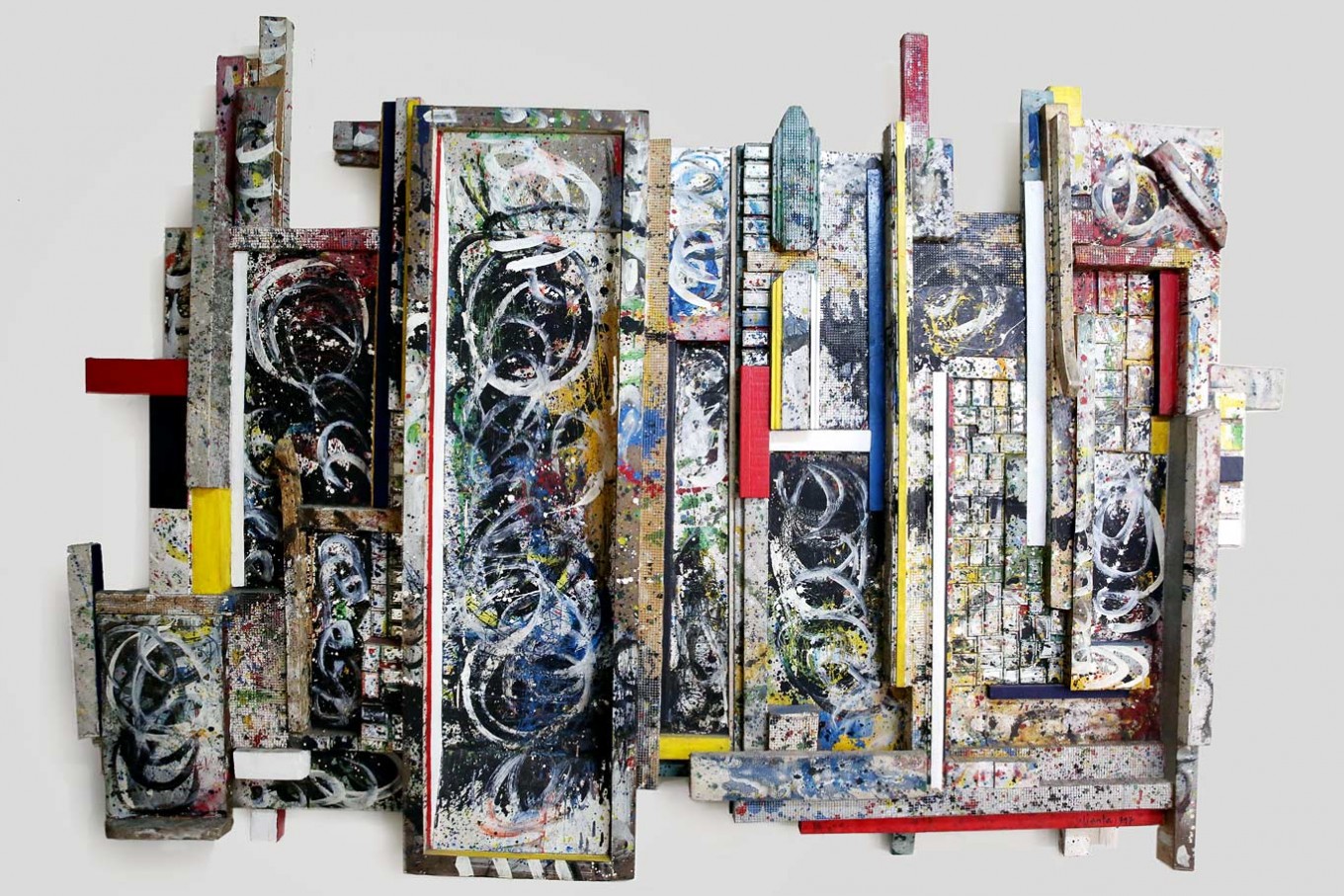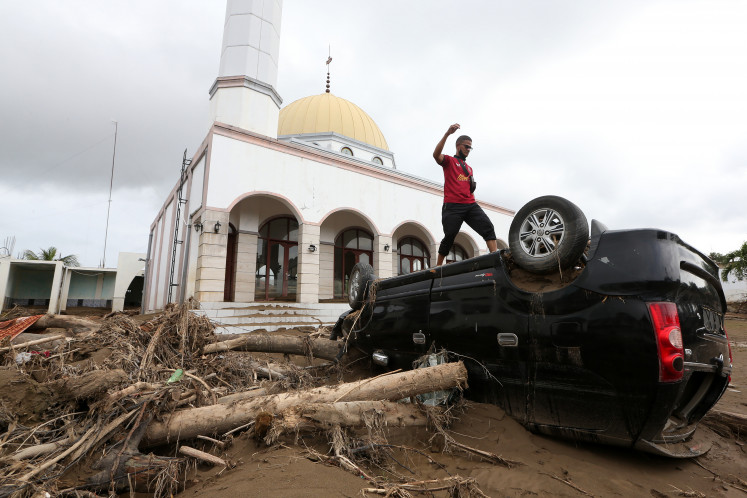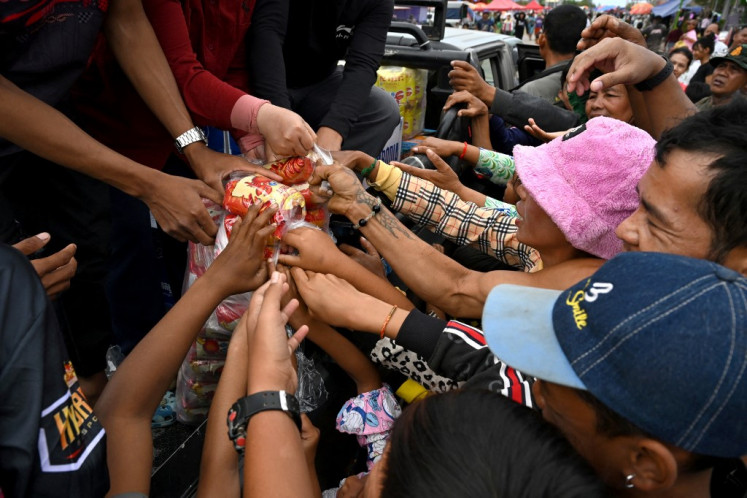Popular Reads
Top Results
Can't find what you're looking for?
View all search resultsPopular Reads
Top Results
Can't find what you're looking for?
View all search results'Run for Manhattan': Beyond an artistic statement
A new exhibition showcases how Made Wianta made Balinese art modern, and then, through his relentless questioning, also made it contemporary.
Change text size
Gift Premium Articles
to Anyone
I
n his early graphic works, the 1980s Karangasem series, Made Wianta, the maestro of modern Balinese art, explored the Balinese subconscious. The first and arguably only artist to do so.
On the last day of the millennium, he gathered two thousand youths on Sanur Beach who held a two thousand meter long cloth on which the word “peace” was written in all the world’s languages. Three years later, large photographs painted by him with blood and exhibited at Gaya Gallery in Ubud, Bali, came as a long scream of pain at the horror of the Kuta bombing.
More recently, he created a fantastic installation using car exhaust pipes, now on display in Singapore.
In between, he has been a painter — playing now with color dots, geometry and lyrical calligraphic brush strokes, in an unending outpouring of creative energy that was also inventory of the expressive power of color abstraction.
He had risen to become one the most esteemed figures in the Indonesian and Balinese art worlds. Then, suddenly, he disappeared. His voice, that of a dissenting maverick, was heard no more in the art circles. No news of an exhibition he was planning in Guam or a theater performance he was preparing in the United States. It was as if he were gone.
Some people knew the reason behind this sudden absence, and long silence. It was not his demise, but it could have been.
In his home village of Apuan in Baturiti, Bali, which he had always tried to leave but always found himself coming back to, Wianta had a motorbike accident, which turned out into a stroke. He was left virtually paralyzed.
The most active of Indonesian artist seemed immobilized. But no, Wianta’s energy was still there, if not in his body, then in his mind. He would reemerge from the darkness of those days. He would be creative once again.
With proper medical care, massage, a good diet and the love of his family, over the last two years life has slowly begun returning to his limbs and to his hands. He yearned to be creative again, all prayed he would be. And eventually his longing came to be.
Wianta caught the attention of Ciptadana Artspace at the Ciptadana Center, which has decided to hold a retrospective exhibition of his works in Jakarta that runs until Dec. 8.
The exhibition is an invitation to think about the passing of time, as Wianta seeks to continue his recovery so that he can once again make the fantastic Karangasem drawings with which he began his career, and pursue other new, creative endeavors.
The exhibition is titled “Run for Manhattan.” It is not a pun, but a reference to his line of creative expression when he had this stroke.
What is Run, you might ask? Before Wianta brought attention to the tiny, remote island of Run in the Moluccas, it had remained arguably the most neglected historical place in the country — possibly the world.
Why is it so important? Because if Run had remained part of the British empire in the 17th century, it is possible that New Amsterdam, a settlement on the tip of Manhattan island, would have continued to be a Dutch possession, and today there would be no New York City as we know it. And instead of the US there could instead be several countries.
In the 17th century, the Netherlands remained the major maritime power. Britain was emerging, but was still behind. The two empires fought in the Moluccas, and the Dutch decided that Run was a more valuable possession than New Amsterdam, a backwater of little interest that only exported furs. Run, on the other hand produced nutmeg and mace, two major exports of the day.
So the Dutch agreed to sacrifice New Amsterdam to claim control of Run in the treaty of Breda. It was where the money was. Who could have guessed that the European — mainly British — settlements in North America would become part of a world power three hundred years down the road.
Wianta has long been aware of Run’s historical significance. He still dreams of making a huge installation of nutmeg and clove in front of the United Nations building in New York as a reminder of the injustices and meaninglessness of history.
If you visit Wianta’s exhibition, the odds are that you will be amazed, by “Run for Manhattan” of course, but also, no less importantly, by the artist’s run for expression, the amazing stylistic dynamism that has accompanied his whole career. The way Bali is still there, in the small invisible forms and beings” of his early drawings as well as, later in the repetitive patterns of his abstract words.
You will see in this exhibition how Wianta has made Balinese art modern. But you will also understand how, in his relentless questioning, he has also made it contemporary.
“Run for Manhattan” is not only an artistic statement, it also sees the artist withdraw to history, and thus, become a part of it. Wianta, you has invented forms and colors, and now you question. We all wait for you to come back among us for more. More forms, colors and questions.
Your Opinion Matters
Share your experiences, suggestions, and any issues you've encountered on The Jakarta Post. We're here to listen.
Thank you
Thank you for sharing your thoughts. We appreciate your feedback.











